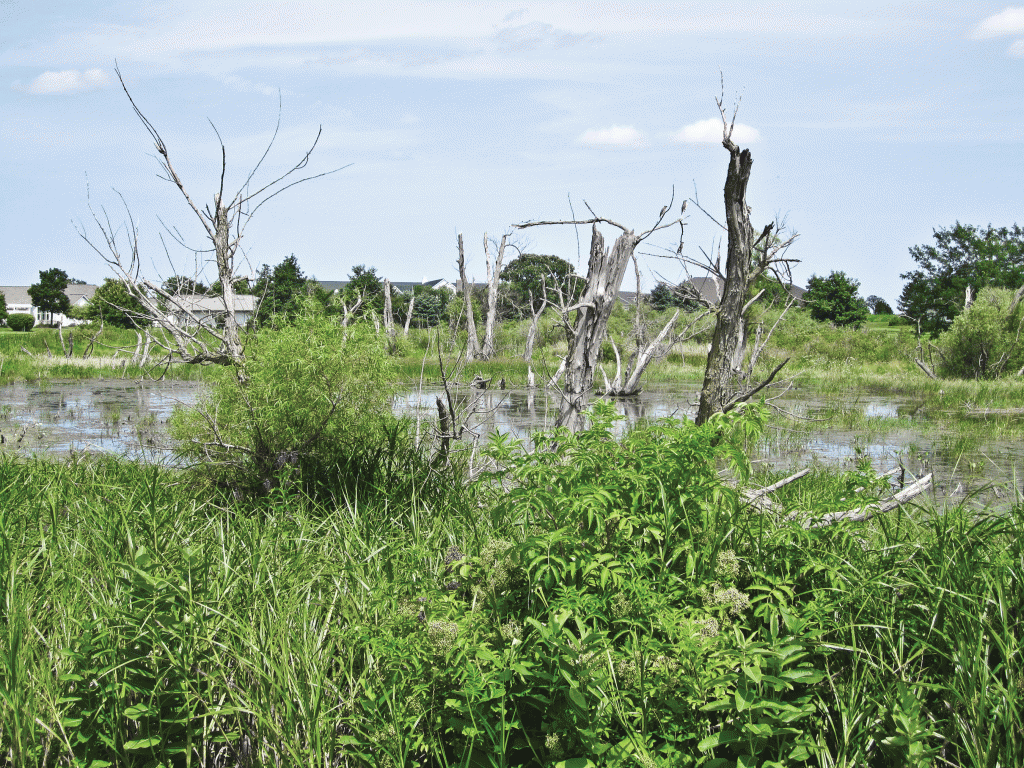They’re wet, muggy, and full of dead trees, but Sun City would not be the same without its wetlands
SUN CITY – Ever take a ride or walk around Sun City to explore other neighborhoods, parks, recreational facilities, wetlands, or marshes?
Yes, that list included wetlands and marshes. Ever wonder why they’re there? What is their purpose? Who manages these areas? How much of Sun City is marshland?
Are they just swamps or ugly areas that can’t be made into home sites? There’s usually water in them; if I live next to one, will it flood my yard or basement? Is there wildlife in them?
About 305 of the 2,700 acres occupied by Sun City are wetlands, which are specific sites designated for protection and management by federal and state governments. The largest and most prominent wetland in the community is Wildflower Park. Nearly a dozen other smaller sites are scattered throughout the subdivision’s neighborhoods.
A wetland is defined by scientists as an area between deep water and dry land. It may hold standing water year-round or for only a few weeks, but to be a wetland, it must be an area where plants have formed and have adapted to water.

Sun City’s wetlands, like this one on Cold Springs Drive near Golf View Drive, were here long before any homes were ever constructed in the area. (Chris La Pelusa/Sun Day Photo)
“Del Webb did not create these wetlands. They were here long before any of us came here,” Chris Lueck, landscape services supervisor who oversees the management and care of wetlands in Sun City, said. “Before the developer could put a shovel into the ground here, these wetlands had to be identified by experts, and Sun City’s homes had to be built around them, so they could be preserved.”
All of Sun City’s wetland sites are marshes. They normally have a few inches or feet of standing water and rooted plants that emerge above water. Emergents are usually bullrushes, cordgrass, or cattails. In other areas, wetlands can be in forests, wet meadows, bogs, or low areas covered by natural water, according to the Wetlands Initiative, an environmental educational organization in Illinois.
Contrary to some beliefs, wetlands are not just ugly, undesirable, and abandoned sites. They are carefully managed areas that serve many highly desirable environmental purposes. They shouldn’t be confused with man-made retention ponds or basins, such as Wildflower Lake and Fountain View’s decorative pond, Dave Osborn, director of maintenance for the Sun City Association staff, said.
“Wetlands serve many purposes and possess their own unique beauty,” Lueck said. “They improve water quality by absorbing and filtering out pollutants and sediments in water; they prevent flooding by acting as a sponge, slowing down the force of potential flood waters as they travel downstream. They provide habitat for many forms of wildlife; they support a healthy environment through biodiversity, provide valuable open space, and prevent overcrowded developments, and they create recreational opportunities such as fishing, birdwatching, hiking, and even landscape photography.”
Wetlands are home to muskrats, egrets, and other wild birds, frogs, myriad insects, ducks, herons, butterflies, dragonflies, and salamanders. All of these species depend on wetlands to survive, especially in developed urban and suburban areas.
Sun City’s wetlands are actually managed by Hey and Associates, Inc., one of many environmental control companies in Illinois.
“Their main task is to restore and in some cases create natural habitat through a combinaof controlling invasive or weedy vegetation and re-introducing native vegetation,” Lueck said. “These invasive weeds can sometimes out-compete the native plants. In some disturbed areas that lack native vegetation, we have introduced live plants and seeds that are consistent with native species that grow in natural areas. These areas are managed according to guidelines in perpetuity established by the U.S. Army Corps. of Engineers.”
This management activity costs Sun City about $60,000 a year, Osborn said.
The U.S. Clean Water Act, enacted in 1972, requires that anyone obtain a permit before placing dredged or fill material in any waters of the nation, including wetlands. The Act also now regulates all activities in wetlands, and the enforcement arm is the ACOE.
One Sun City wetland is an Illinois nature preserve protected by the Illinois Nature Preserves Commission, which works with the Del Webb Sedge Meadow and Grove Dedicated Nature Preserve. It is located along Briar Hill Road in the northwest corner of the development.
“On this site we have at least one Blanding’s Turtle, which is an endangered species whose habitats have been almost eliminated by development,” Osborn said.
Wetlands typically contain dead trees, which some find ugly. Osborn said these trees, or snags, as they are called by scientists, are not just simply dead trees. According to the McHenry County Conservation District, snags provide wildlife habitats for food, nesting, and shelter. They contain hunting perches for hawks and insect-eating birds, hibernation and metamorphic places for butterflies and moths, and help anchor the soil and prevent erosion.
In addition to Wildflower Park, some other wetlands are located as follows:
• Two on Cold Springs Drive – one across from Golf View Drive and another near Oak Grove Drive.
• On Farm Hill Drive next to Whisper Creek Golf Course, south of Cold Springs.
• The state preserve between neighborhoods 37 and 36, near Community Gardens.
• Between Neighborhoods 36 and 27 north of Clanyard Road.
• The south end of Neighborhood 30.
• In Neighborhood 28, at the north end of Windsor Drive.
• Next to the Millgrove Woodshop in Neighborhood 21, behind Crestview Drive.




